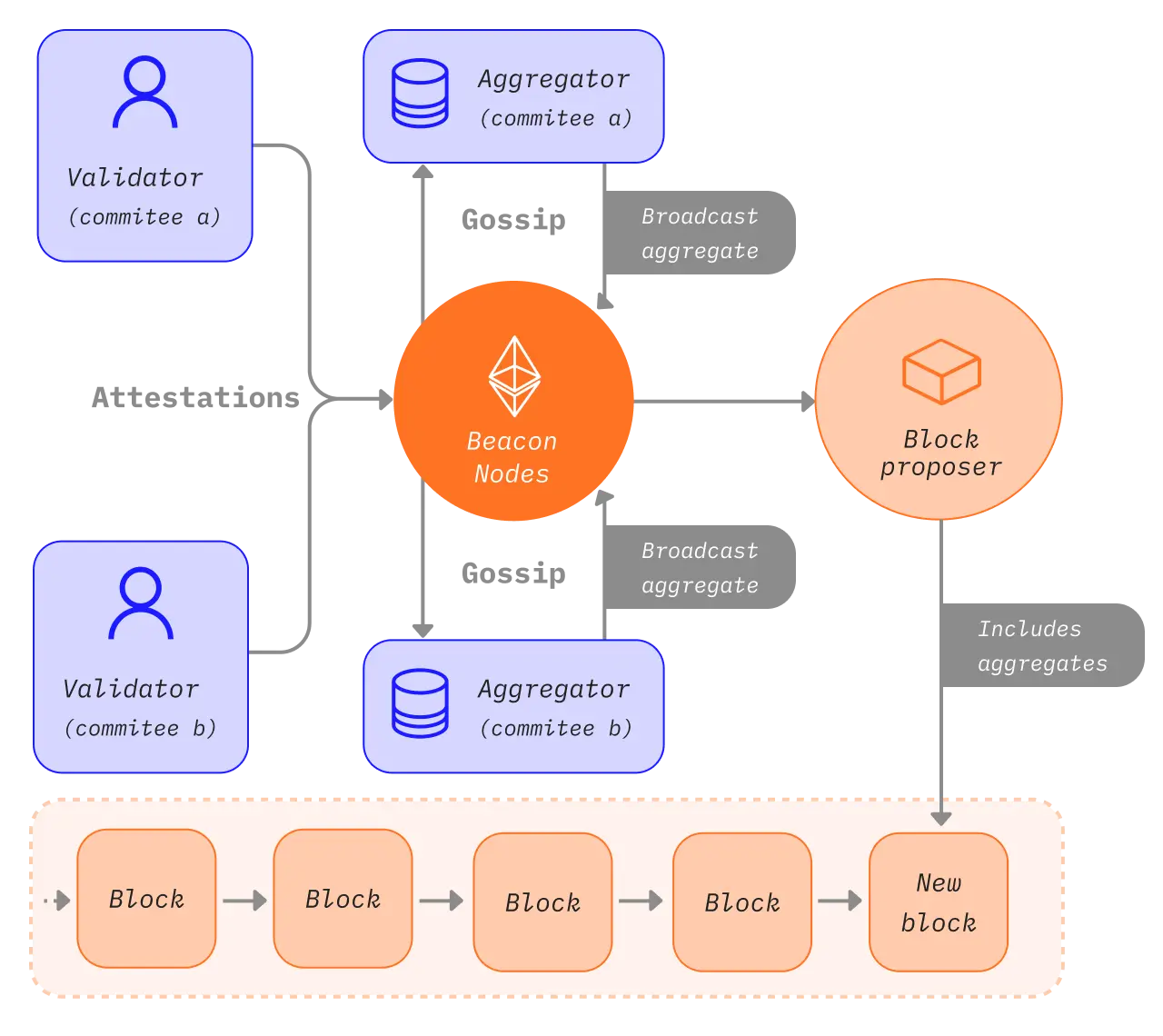Attestations
A validator is expected to create, sign and broadcast an attestation during every epoch. This page outlines what these attestations look like and how they are processed and communicated between consensus clients.
What is an attestation?
Every (6.4 minutes) a validator proposes an attestation to the network. The attestation is for a specific slot in the epoch. The purpose of the attestation is to vote in favor of the validator's view of the chain, in particular the most recent justified block and the first block in the current epoch (known as source and target checkpoints). This information is combined for all participating validators, enabling the network to reach consensus about the state of the blockchain.
The attestation contains the following components:
aggregation_bits: a bitlist of validators where the position maps to the validator index in their committee; the value (0/1) indicates whether the validator signed thedata(i.e. whether they are active and agree with the block proposer)data: details relating to the attestation, as defined belowsignature: a BLS signature that aggregates the signatures of individual validators
The first task for an attesting validator is to build the data. The data contains the following information:
slot: The slot number that the attestation refers toindex: A number that identifies which committee the validator belongs to in a given slotbeacon_block_root: Root hash of the block the validator sees at the head of the chain (the result of applying the fork-choice algorithm)source: Part of the finality vote indicating what the validators see as the most recent justified blocktarget: Part of the finality vote indicating what the validators see as the first block in the current epoch
Once the data is built, the validator can flip the bit in aggregation_bits corresponding to their own validator index from 0 to 1 to show that they participated.
Finally, the validator signs the attestation and broadcasts it to the network.
Aggregated attestation
There is a substantial overhead associated with passing this data around the network for every validator. Therefore, the attestations from individual validators are aggregated within subnets before being broadcast more widely. This includes aggregating signatures together so that an attestation that gets broadcast includes the consensus data and a single signature formed by combining the signatures of all the validators that agree with that data. This can be checked using aggregation_bits because this provides the index of each validator in their committee (whose ID is provided in data) which can be used to query individual signatures.
In each epoch 16 validators in each subnet are selected to be the aggregators. The aggregators collect all the attestations they hear about over the gossip network that have equivalent data to their own. The sender of each matching attestation is recorded in the aggregation_bits. The aggregators then broadcast the attestation aggregate to the wider network.
When a validator is selected to be a block proposer they package aggregate attestations from the subnets up to the latest slot in the new block.
Attestation inclusion lifecycle
- Generation
- Propagation
- Aggregation
- Propagation
- Inclusion
The attestation lifecycle is outlined in the schematic below:
Rewards
Validators are rewarded for submitting attestations. The attestation reward depends on the participation flags (source, target and head), the base reward and the participation rate.
Each of the participation flags can be either true or false, depending on the submitted attestation and its inclusion delay.
The best scenario occurs when all three flags are true, in which case a validator would earn (per correct flag):
reward += base reward * flag weight * flag attesting rate / 64
The flag attesting rate is measured using the sum of effective balances of all attesting validators for the given flag compared the total active effective balance.
Base reward
The base reward is calculated according to the number of attesting validators and their effective staked ether balances:
base reward = validator effective balance x 2^6 / SQRT(Effective balance of all active validators)
Inclusion delay
At the time when the validators voted on the head of the chain (block n), block n+1 was not proposed yet. Therefore attestations naturally get included one block later so all attestations who voted on block n being the chain head got included in block n+1 and, the inclusion delay is 1. If the inclusion delay doubles to two slots, the attestation reward halves, because to calculate the attestation reward the base reward is multiplied by the reciprocal of the inclusion delay.
Attestation scenarios
Missing Voting Validator
Validators have a maximum of 1 epoch to submit their attestation. If the attestation was missed in epoch 0, they can submit it with an inclusion delay in epoch 1.
Missing Aggregator
There are 16 Aggregators per epoch in total. In addition, random validators subscribe to two subnets for 256 epochs and serve as a backup in case aggregators are missing.
Missing block proposer
Note that in some cases a lucky aggregator may also become the block proposer. If the attestation was not included because the block proposer has gone missing, the next block proposer would pick the aggregated attestation up and include it into the next block. However, the inclusion delay will increase by one.
Further reading
Know of a community resource that helped you? Edit this page and add it!
